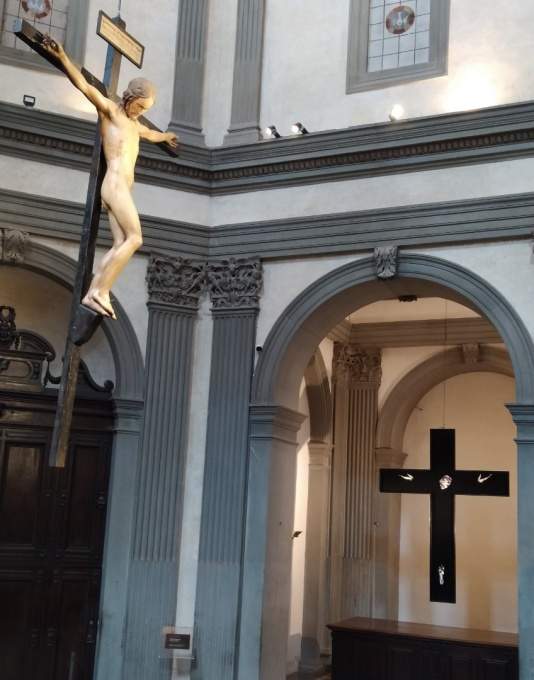As part of the celebrations for the 20th anniversary of the return of Michelangelo ’s (Caprese, 1475 - Rome, 1564) Crucifixion to the monumental complex of Santo Spirito in Florence, the Augustinian community will welcome the presence of Lorenzo Puglisi ’s (Biella, 1971) Crucifixion, right next to Buonarroti’s Santo Spirito Crucifix. In fact, on Saturday, September 19, in the Basilica of Santo Spirito in Florence, the exhibition Lorenzo Puglisi | Before Michelangelo opens. Crucifixion, humanity, mystery: organized by Francesca Sacchi Tommasi of Etra studio in collaboration with ArtCom Project, the exhibition features Puglisi’s painting of the Crucifixion alongside the famous wooden Crucifix, an early work by Michelangelo Buonarroti, in the Sacristy of the Florentine Basilica. The exhibition will remain on view until November 1, 2020.
The wooden Crucifix that Michelangelo Buonarroti carved between 1493 and 1494 “to please the prior,” that is, to thank him for his hospitality and the opportunity to study anatomy, had remained in “hiding” for centuries, meaning that traces of it had been lost. However, its existence was witnessed in Vasari’s writings, and it was precisely this that prompted scholar Margrit Lisner to deepen her research, which, thanks to the hospitality of Augustinian Father Guido Balestri, enabled the discovery of the Naked Christ and its attribution to Michelangelo. From 1962, the year of its rediscovery, until today, the Crucifix has experienced a long history that has led it to Casa Buonarroti, where it remained until December 2000, when the Augustinians, after many attempts, succeeded in bringing it back “home.”
In the Basilica of Santo Spirito, however, due to architectural transformations it could not be restored to its original location - occupied by the Caccini altar - so the Barbadori Chapel of Giuliano da Sangallo’s Sacristy was chosen. Now, in one of the basilicas symbolic of the Florentine Diladdarno, for about 40 days the Crucifix of Santo Spirito and the Crucifixion by Lorenzo Puglisi, an artist who lives and works in Bologna, and who has created an oil painting on poplar board shaped in the form of a cross (reviving an art-historical tradition that originates from the painting of the primitives and that incontemporary art had been completely lost), with a black background, on which appear only the results of his “search for essentiality,” namely the representations of the inclined head, hands and feet of the dead Christ on the cross.
As Father Giuseppe Pagano, prior of Santo Spirito, writes, “Lorenzo Puglisi will be before Michelangelo to express all the force of the Crucifixion, all Humanity and Mystery. Thus Lorenzo’s interest in human nature and the mystery of existence remains, seeking to depict it with a painting in the dark, as if to express that light that is there, that pushes, but that is still held back by darkness, just as Michelangelo breaks down the reality of death on the cross with the beauty and the smile that are already an expression of a reality other than what is seen.”
The artist explains that “the Crucifixion is an image that is both symbolic and real, both in the Christian tradition and in the most intimate reflection on man’s condition, possibility and raison d’être, as can be understood from the knowledge transmitted to us over time by the ancients, in numerous forms. The vision of Michelangelo’s sculpture touches the heart and has a lightness and delicacy that is rare. For me as a painter, the need to seek vital, sculptural painting emerged immediately, and Michelangelo was a great master of this. So my attempt at painting is directed toward the vision of something that is other than the empirical visible, but with which it is inseparably intertwined, it is mixed with it; the search for the essential of representation, as an ambition and an end, is linked to the search for essentiality in life and is its consequence and hope of knowing. Crucifixion, humanity, mystery. It is all in these three words.”
For all information you can visit the official website of the Basilica of the Holy Spirit.
Pictured: the Crucifix by Michelangelo and the Crucifixion by Puglisi.
 |
| Michelangelo Buonarroti's Crucifix compared with that of Lorenzo Puglisi |
Warning: the translation into English of the original Italian article was created using automatic tools. We undertake to review all articles, but we do not guarantee the total absence of inaccuracies in the translation due to the program. You can find the original by clicking on the ITA button. If you find any mistake,please contact us.